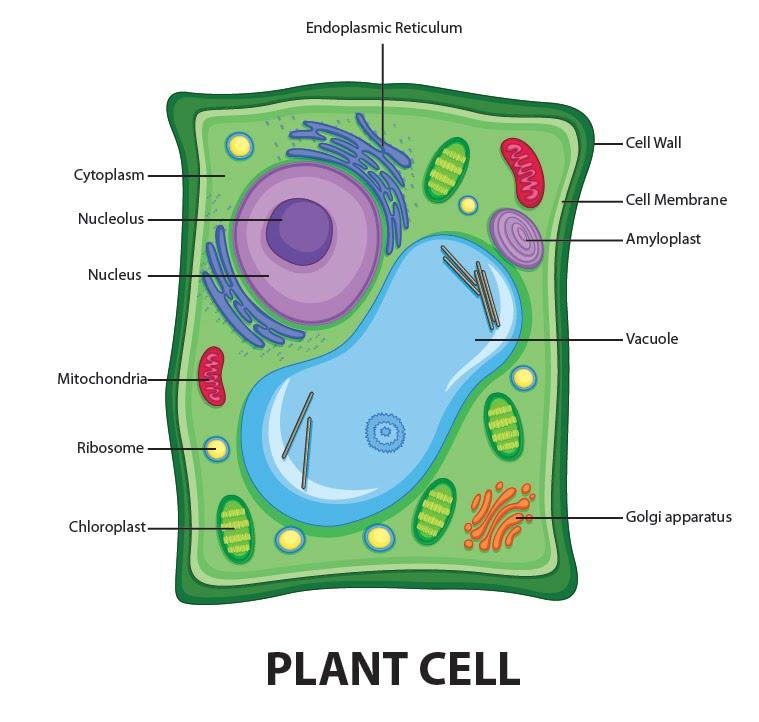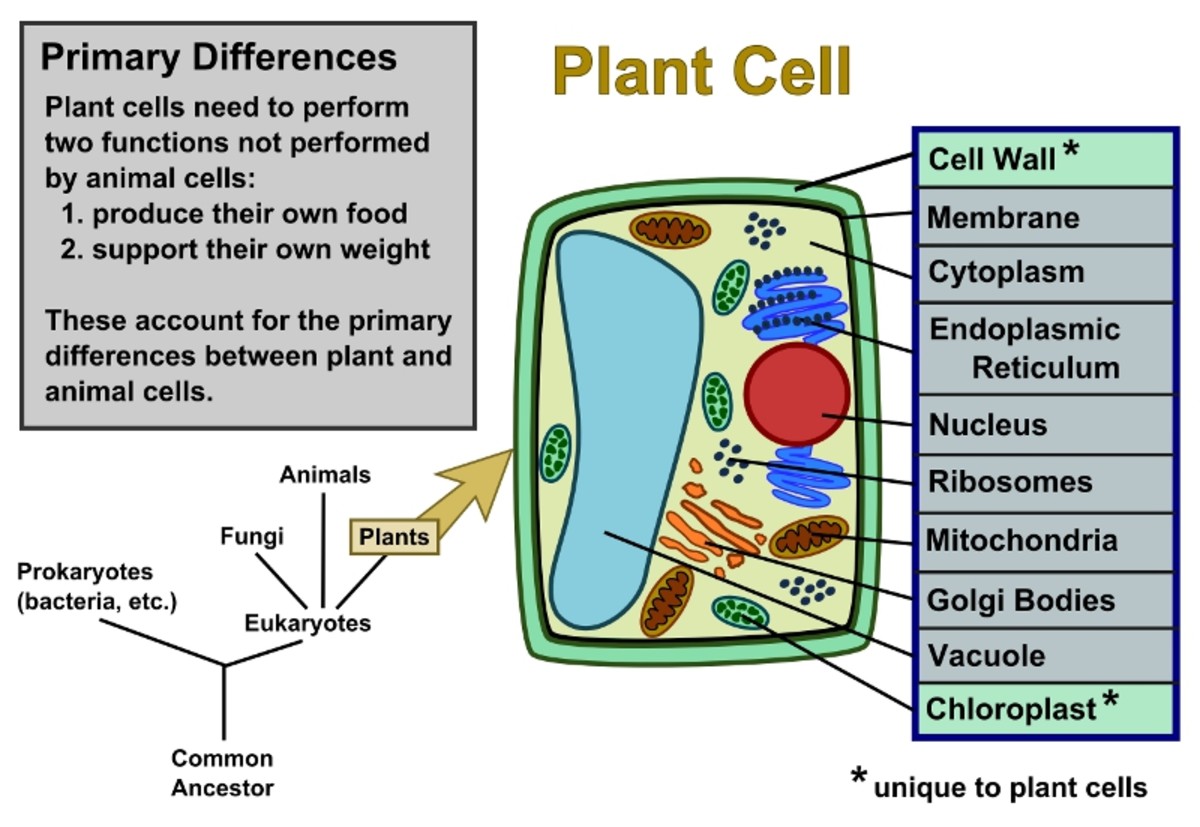
Plant Cell Diagram Labeled Class 9 Labeled Functions and Diagram
Figure 10.1.5 10.1. 5: A micrograph of a cell nucleus. The nucleolus (A) is a condensed region within the nucleus (B) where ribosomes are synthesized. The nucleus is surrounded by the nuclear envelope (C). Just oustide the nucleus, the rough endoplasmic reticulum (D) is composed of many layers of folded membrane.

Diagrams of Plant Cell 101 Diagrams
Plant cells are eukaryotic cells, that are found in green plants, photosynthetic eukaryotes of the kingdom Plantae which means they have a membrane-bound nucleus. They have a variety of membrane-bound cell organelles that perform various specific functions to maintain the normal functioning of the plant cell. Table of Contents

plant cell labeled Classical Conversations Cycle 1 Science cells
3. DNA, the heredity information of cells, which can be found in a nucleus of eukaryotic cells and the a nucleoid region of prokaryotic cell. 4. ribosomes, or protein-synthesizing structures composed of ribosomes and proteins. These structures can be found on the image of the plant cell (Figure 3.1.2.1 3.1.2. 1 ).

Plant Cell Diagram, Definition, Structure, Function & Parts
The parenchyma cells are the most common cell type and are found in the vascular bundles, leaves, and epidermis of the plant. Some common examples of parenchyma cells are guard cells, chlorenchyma cells (involved in photosynthesis). iii. Collenchyma Cells: Collenchyma tissues are made of collenchyma cells. They also do not have a secondary cell.

Plant cell diagram Plant cell diagram, Cell diagram, Plant cell
Plant cells are the basic unit and building blocks of life in organisms of the kingdom Plantae. They are cells that have a distinct nucleus and other cellular organelles enclosed within a membrane and thus are eukaryotic in origin. A model of a typical plant cell is found to be rectangular in shape, ranging in size from 10 to 100 µm.

Plant Cell Structure, Parts, Functions, Labeled Diagram
Plant cells comprise several organelles, each with unique functions vital to the cell's operation: Cell Wall: The cell wall is a rigid layer that provides support, protection, and shape to the cell. It consists mainly of cellulose. Plasma Membrane: This is a semi-permeable membrane that controls the movement of substances in and out of the cell.

plantcelldiagram Tim's Printables
The structures possessed by plant cells for performing these two functions create the primary differences between plant and animal cells. Structures Unique to Plant Cells. Cell Wall: A wall on the outside of the membrane, which, in combination with the vacuole (as described below), helps the plant cell maintain its shape and rigidity.

Plant Cell Parts and Structure
This will teach you how to draw plant cell diagram easily. This is a step-by-step dr. #plantcell #howtodraw #adimushowThis is an easy drawing of a plant cell.

Draw a welllabelled diagram of a plant cell.
plant cell, the basic unit of all plants.Plant cells, like animal cells, are eukaryotic, meaning they have a membrane-bound nucleus and organelles.The following is a brief survey of some of the major characteristics of plant cells. For a more in-depth discussion of cells, see cell. Unlike animal cells, plant cells have a cell wall surrounding the cell membrane.

Anatomy Of A Plant Cell
Explore the microscopic world of plant cells with our plant cell labelling worksheet. This activity requires no preparation and seeks to give students a thorough understanding of plant cell parts and functions. By cutting and pasting the labels onto a plant cell diagram, students will explore the intricate structures within these unique units.

Plant Cells Vs. Animal Cells (With Diagrams) Owlcation
Structure of a plant cell. Plant cells are the cells present in green plants, photosynthetic eukaryotes of the kingdom Plantae.Their distinctive features include primary cell walls containing cellulose, hemicelluloses and pectin, the presence of plastids with the capability to perform photosynthesis and store starch, a large vacuole that regulates turgor pressure, the absence of flagella or.

Diagrammatic representation of a generalized plant cell depicting the
Animal and plant cells have certain structures in common. A jelly-like material that contains dissolved nutrients and salts and structures called organelles. It is where many of the chemical.
.svg/1280px-Simple_diagram_of_plant_cell_(en).svg.png)
FileSimple diagram of plant cell (en).svg Wikimedia Commons
Diagram of a typical animal cell: Image modified from OpenStax Biology. Diagram of a typical plant cell: Image modified from OpenStax Biology. Both animal and plant cells have mitochondria, but only plant cells have chloroplasts. Plants don't get their sugar from eating food, so they need to make sugar from sunlight.

Plant Cell Parts and Structure
Definition of plant cell. Plant cell is a eukaryotic cell found in green plants, which are photosynthetic eukaryotes that belong to the kingdom Plantae and have a membrane-bound nucleus. Plant cell include a variety of membrane-bound organelles that perform various functions to maintain the health of the plant cell.

Label the Parts of the Plant and Animal Cell Biology LibreTexts
Plant Cell Structure and Parts Explained With a Labeled Diagram - Biology Wise Plant Cell Structure and Parts Explained With a Labeled Diagram We know plants from time immemorial and they are a part of our day-to-day life, either directly or indirectly, but do we actually know what does a plant cell structure look like?

Plant Cell Diagram, Definition, Structure, Function & Parts
A Labeled Diagram of the Plant Cell and Functions of its Organelles - Biology Wise A Labeled Diagram of the Plant Cell and Functions of its Organelles We are aware that all life stems from a single cell, and that the cell is the most basic unit of all living organisms.